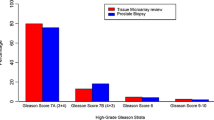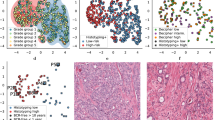Abstract
In this study we addressed the question whether nuclear grading in very small samples of prostate cancer would provide additional prognostic information as compared to Gleason grading. Therefore, a tissue microarray (TMA) was constructed comprising a total number of 3,261 prostate cancers. Blinded for all clinical and pathological data, the TMA spots (diameter 0.6 mm) containing cancer were graded with two systems: First, for nuclear features according to a modified Fuhrman grading system, and second, by using a simplified Gleason system. The results were compared with tumour stage, tumour grade and follow-up data. Although nuclear grading could easily be performed on the TMA spots, no correlation was found with tumour stage, grade or PSA recurrence after prostatectomy. However, Gleason grading, even when performed on the small TMA spots, provided significant prognostic information. Correlation with Gleason scores determined in the complete prostatectomy specimens showed moderate agreement in low-grade (score ≤ 6) or intermediate (score = 7) tumours, but poor agreement with high-grade (score ≥ 8) tumours. In conclusion, the Fuhrman grading of prostate cancer does not appear to be of any prognostic importance so the Gleason grading remains the system of choice, even in tumour specimens smaller than 1 mm.


Similar content being viewed by others
Abbreviations
- PSA:
-
prostate-specific antigen
- TMA:
-
tissue microarray
- H&E:
-
hematoxylin and eosin
References
Gleason DF (1966) Classification of prostatic carcinomas. Cancer Chemother Rep 50:125–128
Gleason DF, Mellinger GT (1974) Prediction of prognosis for prostatic adenocarcinoma by combined histological grading and clinical staging. J Urol 111:58–64
Gleason DF (1992) Histologic grading of prostate cancer: a perspective. Hum Pathol 23:273–279
Epstein JI, Pizov G, Walsh PC (1993) Correlation of pathologic findings with progression after radical retropubic prostatectomy. Cancer 71:3582–3593
Oesterling JE, Brendler CB, Epstein JI et al (1987) Correlation of clinical stage, serum prostatic acid phosphatase and preoperative Gleason grade with final pathological stage in 275 patients with clinically localized adenocarcinoma of the prostate. J Urol 138:92–98
Di Silverio F, D’Eramo G, Buscarini M et al (1996) DNA ploidy, Gleason score, pathological stage and serum PSA levels as predictors of disease-free survival in C-D1 prostatic cancer patients submitted to radical retropubic prostatectomy. Eur Urol 30:316–321
Sogani PC, Israel A, Lieberman PH et al (1985) Gleason grading of prostate cancer: a predictor of survival. Urology 25:223–227
Bostwick DG, Foster CS (1999) Predictive factors in prostate cancer: current concepts from the 1999 College of American Pathologists Conference on Solid Tumor Prognostic Factors and the 1999 World Health Organization Second International Consultation on Prostate Cancer. Semin Urol Oncol 17:222–272
Humphrey PA (2004) Gleason grading and prognostic factors in carcinoma of the prostate. Mod Pathol 17:292–306
Epstein JI, Carmichael M, Partin AW et al (1993) Is tumor volume an independent predictor of progression following radical prostatectomy? A multivariate analysis of 185 clinical stage B adenocarcinomas of the prostate with 5 years of followup. J Urol 149:1478–1481
Epstein JI, Carmichael MJ, Pizov G et al (1993) Influence of capsular penetration on progression following radical prostatectomy: a study of 196 cases with long-term followup. J Urol 150:135–141
Egan AJ, Bostwick DG (1997) Prediction of extraprostatic extension of prostate cancer based on needle biopsy findings: perineural invasion lacks significance on multivariate analysis. Am J Surg Pathol 21:1496–1500
Sagalowsky AI, Milam H, Reveley LR (1982) Prediction of lymphatic metastases by Gleason histologic grading in prostatic cancer. J Urol 128:951–952
Gaeta JF, Asirwatham JE, Miller G et al (1980) Histologic grading of primary prostatic cancer: a new approach to an old problem. J Urol 123:689–693
Böcking A, Kiehn J, Heinzel-Wach M (1982) Combined histologic grading of prostatic carcinoma. Cancer 50:288–294
Zhou M, Hayasaka S, Taylor JM et al (2001) Lack of association of prostate carcinoma nuclear grading with prostate specific antigen recurrence after radical prostatectomy. J Urol 166:2193–2197
Khan MA, Walsh PC, Miller MC et al (2003) Quantitative alterations in nuclear structure predict prostate carcinoma distant metastasis and death in men with biochemical recurrence after radical prostatectomy. Cancer 98:2583–2591
Veltri RW, Miller MC, Isharwal S et al (2008) Prediction of prostate-specific antigen recurrence in men with long-term follow-up postprostatectomy using quantitative nuclear morphometry. Cancer Epidemiol Biomark Prev 17:102–110
Fuhrman SA, Lasky LC, Limas C (1982) Prognostic significance of morphologic parameters in renal cell carcinoma. Am J Surg Pathol 6:655–663
Bubendorf L, Kononen J, Koivisto P et al (1999) Survey of gene amplifications during prostate cancer progression by high-throughout fluorescence in situ hybridization on tissue microarrays. Cancer Res 59:803–806
Schlomm T, Kirstein P, Iwers L et al (2007) Clinical significance of epidermal growth factor receptor protein overexpression and gene copy number gains in prostate cancer. Clin Cancer Res 13:6579–6584
Schlomm T, Iwers L, Kirstein P et al (2008) Clinical significance of p53 alterations in surgically treated prostate cancers. Mod Pathol 21:1371–1378
Erbersdobler A, Isbarn H, Steiner I et al (2009) Predictive value of prostate-specific antigen expression in prostate cancer: a tissue microarray study. Urology 74:1169–1173
DeMarzo AM, Nelson WG, Isaacs WB et al (2003) Pathological and molecular aspects of prostate cancer. Lancet 361:955–964
Epstein JI (2004) Diagnosis and reporting of limited adenocarcinoma of the prostate on needle biopsy. Mod Pathol 17:307–315
Diamond DA, Berry SJ, Umbricht C et al (1982) Computerized image analysis of nuclear shape as a prognostic factor for prostatic cancer. Prostate 3:321–332
Partin AW, Walsh AC, Pitcock RV et al (1982) A comparison of nuclear morphometry and Gleason grade as a predictor of prognosis in stage A2 prostate cancer: a critical analysis. J Urol 142:1254–1258
Robutti F, Pilato FP, Betta PG (1989) A new method of grading malignancy of prostate carcinoma using quantitative microscopic nuclear features. Pathol Res Pract 185:701–703
Fujikawa K, Sasaki M, Arai Y et al (1997) Prognostic criteria in patients with prostate cancer: Gleason score versus volume-weighted mean nuclear volume. Clin Cancer Res 3:613–618
Acknowledgements
The authors would like to thank Dr. Albrecht Stenzinger for reading the manuscript.
Author information
Authors and Affiliations
Corresponding author
Rights and permissions
About this article
Cite this article
Wittschieber, D., Köllermann, J., Schlomm, T. et al. Nuclear Grading Versus Gleason Grading in Small Samples Containing Prostate Cancer: A Tissue Microarray Study. Pathol. Oncol. Res. 16, 479–484 (2010). https://doi.org/10.1007/s12253-010-9270-x
Received:
Accepted:
Published:
Issue Date:
DOI: https://doi.org/10.1007/s12253-010-9270-x




